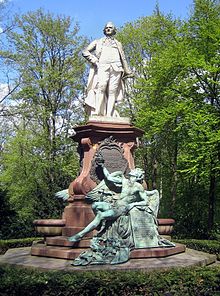Lessing Monument (Berlin)
The Lessing memorial is on Lennéstraße in the extreme southeast of the Great Tiergarten in Berlin-Tiergarten . The ensemble of statue and base with fountain bowls, reliefs and allegorical bronze figures is seven meters high.
History of origin
The decision of the Berlin magistrate to honor three celebrities of German intellectual life - Friedrich Schiller , Johann Wolfgang von Goethe and Gotthold Ephraim Lessing - with a joint memorial in Berlin dates back to 1863 . This plan did not materialize. A Schiller memorial on Gendarmenmarkt , designed by Reinhold Begas , was built between 1868–1871, a Goethe memorial by Fritz Schaper was inaugurated in 1880 in the Großer Tiergarten.
Finally, in 1886, a committee headed by Carl Robert Lessing announced a competition for a Lessing memorial; the initiator was a great-nephew of the poet and the main owner of the Vossische Zeitung , for which his ancestor had written from 1751 to 1755. 27 artists took part in the competition. Otto Lessing , a nephew of the committee chairman and a successful sculptor, received the order, but had to change his design beforehand - the base seemed too simple to the client. On the other hand, at the request of Kaiser Wilhelm I , who had assessed the sketches, the figure of a sphinx on the back of the base was omitted. The construction of the monument lasted from 1887 to 1890, and it was inaugurated on October 14, 1890. In this context Otto Lessing received the title of professor.
description
The white marble statue of the poet is three meters high. The pedestal made of gray and the pedestal made of reddish granite together reach a height of four meters. The sculptures and the inscription panels on the base are made of bronze. In the middle part of the base there are four asymmetrically framed cartouches : on the front of the monument the name Gotthold Ephraim Lessing, on the other sides reliefs of the heads of Moses Mendelssohn , Ewald Christian von Kleist and Friedrich Nicolai . These three - the philosopher, the poet, and the writer and publisher - were among Lessing's friends and intellectual allies.
On the front and back below the cartouches you can see fully plastic, allegorical figures with symbolic additions: in the front under the nameplate the figure of a young man as a genius of humanity with a flaming sacrificial bowl, harp and laurel wreath, plus a plaque with the essential sentences of the ring parable from Lessing's piece Nathan the Wise ; accordingly on the reverse the allegory of criticism - a winged boy wielding a scourge , surrounded by books, scrolls and a lion's skin and accompanied by an owl, the symbol of wisdom. On the left and right of the memorial there were bronze dolphin heads designed as grotesques as gargoyles over a small fountain bowl .
vandalism
The memorial repeatedly suffered from theft and vandalism . In 1923 the tail of the bronze lion on the back was stolen and later replaced. During the Second World War , the cast iron accessories - ornamental grilles, benches, and flower pots - were most likely melted down. The portrait reliefs and the gargoyles disappeared after the end of the war. After 1961, the facility was located directly on the Berlin Wall on an unused and unprotected site; the remaining bronze parts were stored in a depot and survived the decades until the fall of the wall .
In 1987 - on the occasion of the 750th anniversary celebrations in Berlin and in 1991/92, the memorial was fundamentally renovated and supplemented, and the memorial square regained its historical form. But even after that there were more thefts - the new gargoyles were lost as well as the scourge of criticism . The statue of the poet and the bronze figures on the base were repeatedly defaced by smears of paint. Purges take place at greater intervals.
Web links
- Erich Schmidt : Speech for the unveiling of the Berlin Lessing monument in Thiergarten on October 14, 1890
- Detailed description of the monument (stadtentwicklung.berlin.de)
- Biography of the sculptor Otto Lessing ( Memento from November 15, 2007 in the Internet Archive ) (historismus.net)
Coordinates: 52 ° 30 ′ 43 ″ N , 13 ° 22 ′ 30 ″ E





